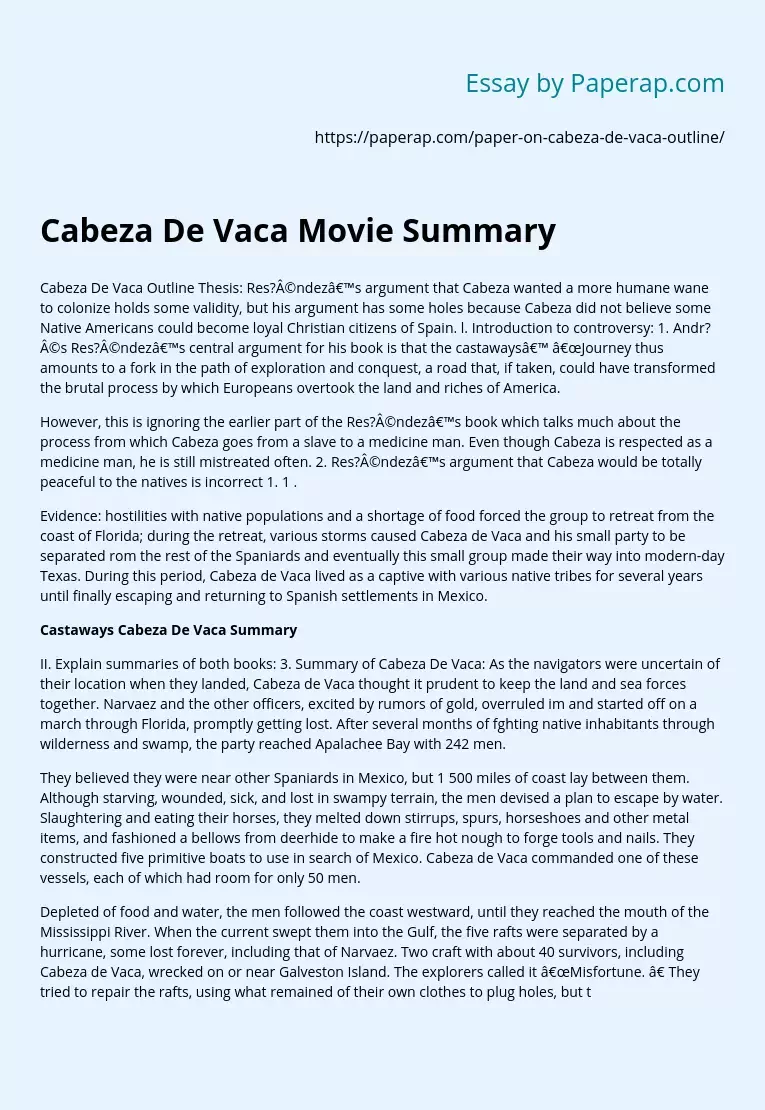Cabeza De Vaca Movie Summary
Cabeza De Vaca Outline Thesis: Res?©ndez’s argument that Cabeza wanted a more humane wane to colonize holds some validity, but his argument has some holes because Cabeza did not believe some Native Americans could become loyal Christian citizens of Spain. l. Introduction to controversy: 1. Andr?©s Res?©ndez’s central argument for his book is that the castaways’ “Journey thus amounts to a fork in the path of exploration and conquest, a road that, if taken, could have transformed the brutal process by which Europeans overtook the land and riches of America.
However, this is ignoring the earlier part of the Res?©ndez’s book which talks much about the process from which Cabeza goes from a slave to a medicine man. Even though Cabeza is respected as a medicine man, he is still mistreated often. 2. Res?©ndez’s argument that Cabeza would be totally peaceful to the natives is incorrect 1. 1 .
Evidence: hostilities with native populations and a shortage of food forced the group to retreat from the coast of Florida; during the retreat, various storms caused Cabeza de Vaca and his small party to be separated rom the rest of the Spaniards and eventually this small group made their way into modern-day Texas.
During this period, Cabeza de Vaca lived as a captive with various native tribes for several years until finally escaping and returning to Spanish settlements in Mexico.
Castaways Cabeza De Vaca Summary
II. Explain summaries of both books: 3. Summary of Cabeza De Vaca: As the navigators were uncertain of their location when they landed, Cabeza de Vaca thought it prudent to keep the land and sea forces together.
Narvaez and the other officers, excited by rumors of gold, overruled im and started off on a march through Florida, promptly getting lost. After several months of fghting native inhabitants through wilderness and swamp, the party reached Apalachee Bay with 242 men.
They believed they were near other Spaniards in Mexico, but 1 500 miles of coast lay between them. Although starving, wounded, sick, and lost in swampy terrain, the men devised a plan to escape by water. Slaughtering and eating their horses, they melted down stirrups, spurs, horseshoes and other metal items, and fashioned a bellows from deerhide to make a fire hot nough to forge tools and nails. They constructed five primitive boats to use in search of Mexico. Cabeza de Vaca commanded one of these vessels, each of which had room for only 50 men.
Depleted of food and water, the men followed the coast westward, until they reached the mouth of the Mississippi River. When the current swept them into the Gulf, the five rafts were separated by a hurricane, some lost forever, including that of Narvaez. Two craft with about 40 survivors, including Cabeza de Vaca, wrecked on or near Galveston Island. The explorers called it “Misfortune. ” They tried to repair the rafts, using what remained of their own clothes to plug holes, but they lost the rafts to a large wave.
As the number of survivors dwindled rapidly, they were enslaved for a few years by various American Indian tribes of the upper Gulf Coast. Only four men including Cabeza de Vaca, survived and escaped to reach Mexico City. Cabeza De Vaca traveled on foot through the then-uncolonized territories of Texas and the coast. Then down the Gulf of California coast to what is ow Mexico, over a period of roughly eight years. He lived in conditions of abject poverty and, occasionally, in slavery.
During his wanderings, passing from tribe to tribe, Cabeza de Vaca developed sympathies for the indigenous population. He became a trader, which allowed him freedom to travel among the tribes. Cabeza de Vaca comprehended his survival and Journey in religious terms, in that he claimed to have been guided by God to learn to heal the sick. He gained such notoriety as a faith healer that he and his companions gathered a large following of natives who egarded them as “children of the sun”, endowed with the power to both heal and destroy 4.
Summary of A Land So Strange: The Epic Journey of Cabeza de Vaca: Ill. Compare similarities: 1. Themes: i. Brutality it. The transition in the role of De Vaca as he travels iii. Religion 2. Setting: Mexico, Texas IV. Compare differences: i. Res?©ndez wrote his book in modern times reflecting back on De Vaca’s Journey and how it would have affected the evolution of Latin America while De Vaca was more of showing the Spanish people how they could be more merciful and better Christians. t.
Perspective: Res?©ndez’s did not experience the hardships that De Vaca did iii. Style of book: Res?©ndez’s is an analysis of a Journey while De Vaca’s is the Journey ‘v. Audience: De Vaca’s audience was the king, to convince him to be more merciful Res?©ndez’s audience is more modern V. Conclusion: l. While Res?©ndez’s has some strong points on the evolution of De Vaca through his journey, I think he fails to emphatize with De Vaca and realize that De Vaca believes that some natives cannot be reformed and must be changed with force.
Cabeza De Vaca Movie Summary. (2019, Dec 05). Retrieved from https://paperap.com/paper-on-cabeza-de-vaca-outline/

